How to Use Herbs For Tea – Fresh or Dried
I love growing and using herbs for tea and in this article, I’m happy to share how to use garden herbs for tea – whether fresh or dried.
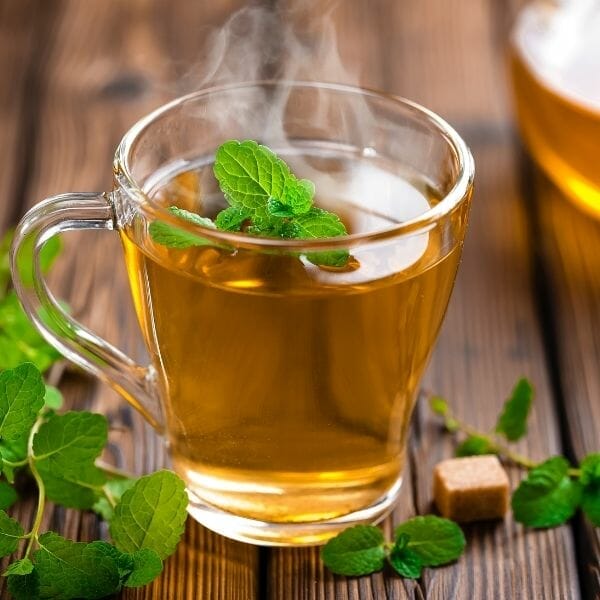
Also Read: Top 9 Herbs to Grow for Tea, How to Make Herbal Iced Tea, Simple Syrup with Herbs, How to Muddle Herbs

How to Make Tea with Herbs
Here’s the general process I use for making tea with garden herbs.
- Use boiling water (100°C/212°F) to brew herbs.
- Use 1-2 Tbsp* of dried herbs or 3-5 Tbsp of fresh herbs per 1 cup of hot water.
- Cover and steep for 3-5** minutes.
Notes:
*The amount of herbs to use varies depending on the type of herb, when it was harvested, how long it’s been stored, growing conditions, etc. Start with 1 Tbsp dried and 3 Tbsp fresh per cup of boiling water and go from there. Experiment to find what works best for you and your homemade tea blends.
**Most garden herbs require steeping for 5 minutes, but some herbs release a bitter flavour steeped too long. Only steep chamomile, lavender, rosemary, rose, orange/lemon peel for 3 minutes.
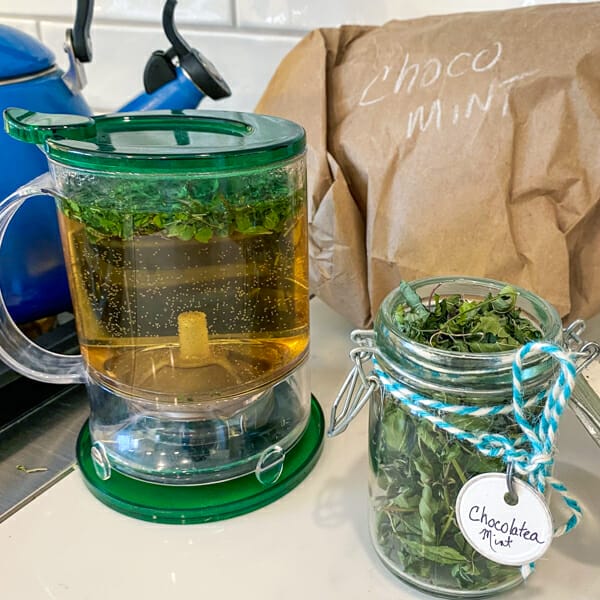
Here are some things I’ve discovered over the years:
- Crush dried herbs a little before steeping to help release essential oils.
- Muddle (gently rub, bruise or crush) fresh herbs to release their essential oils. Don’t crush too hard though, otherwise you’ll release the green chlorophyll which can leave a bitter taste.
- Use three times more fresh herbs than dried herbs.
- The older your dried herbs, the less flavour they’ll have, so you may need to use more.
- Choose one type of herb for your tea or combine several different ones. You could even add dried fruit, flower petals or spices like cinnamon or ginger to your tea.
- Consider adding black, green or oolong tea to the mix. There are no set rules – base your combination on your personal preferences for flavor, color, caffeine, medicinal benefits, etc.
- Don’t expect bright vibrant colours like you get with commercial herbal teas.
- If you want bright colours, consider adding hibiscus, calendula or blue butterfly pea blossoms to your herbal tea mix.
- Lemon balm is best used fresh, it loses its flavour when dried.
Fresh or Dried Herbs for Tea?
You can use both fresh or dried herbs for tea. Personally, I prefer using dried herbs for brewing a hot cup of tea. I find there’s more consistency and it’s easier to store and manage dried herbs.
I often brew tea from fresh herbs if I’ve done some pruning and have a handful of clippings.
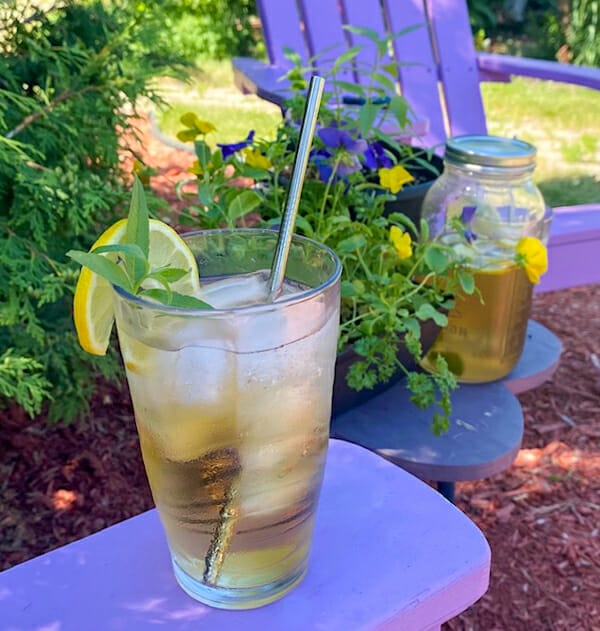
Brewing Fresh Herbs
- use 3-5 Tbsp of fresh herbs per cup of boiling water
- muddle or crush gently to release aroma
- cover and steep 5 minutes or longer
I also like using fresh herbs for iced teas and lemonades – stay tuned for an article on iced teas and lemonade this summer.
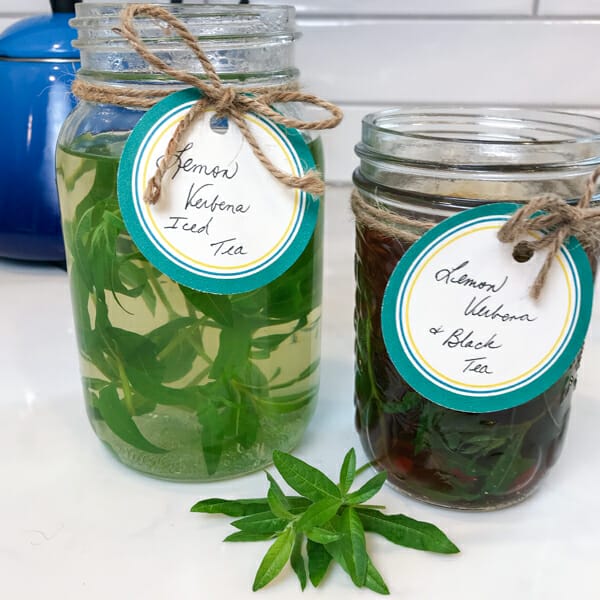
Herbal Tea
Ingredients
- 1 cup water boiled to 100℃/212℉
Choose dry or fresh herbs or use a mix!
- 1-2* Tbsp dry herbs
- 3-5* Tbsp fresh herbs
Instructions
- DRY: Crush dried herbs a little before steeping to help release essential oils.
- FRESH: Muddle (gently rub, bruise or crush) fresh herbs to release their essential oils.
- Pour boiling water over herbs
- Let steep for 3-5** minutes
- Strain and serve simple or with sweetener, to taste.
Video
Notes
- Use three times more fresh herbs than dried herbs.
- When muddling fresh herbs, don’t crush too hard otherwise you’ll release the green chlorophyll which can leave a bitter taste.
- The older your dried herbs, the less flavour they’ll have, so you may need to use more.
- Choose one type of herb for your tea or combine several different ones. You could even add dried fruit, flower petals or spices like cinnamon or ginger to your tea.
- Consider adding black, green or oolong tea to the mix. There are no set rules – base your combination on your personal preferences for flavor, colour, caffeine, medicinal benefits, etc.
- Don’t expect bright vibrant colours like you get with commercial herbal teas.
- If you want bright colours, consider adding hibiscus, calendula or blue butterfly pea blossoms to your herbal tea mix.
- Lemon balm is best used fresh, it loses its flavour when dried.
Nutrition Facts (per serving)
Favourite Herbs for Tea
Here are some common herbs for tea. Also read my post on Top 9 Herbs to Grow for Tea to see which herbs I enjoy growing for tea in my Canadian prairie garden rated to Zone3.
- Chamomile – helps calm nerves, reduce stress, soothe the digestive system and promote sleep
- Hyssop – a lovely scent good for the heart, digestive system and for promoting sleep
- Sage – a woodsy scent to help clear the mind and soothe sore throats
- Rosemary – stimulates circulation to soothe aches and pains, helps clear congestion and boosts mood and memory
- Peppermint – menthol flavor for relaxing muscles, soothing sore throats and relieving stress
- Chocolate Mint – chocolate and peppermint flavor to enjoy and promote relaxation
- Spearmint – great for soothing digestive issues
- Apple Mint & Other Fruit Mints – mild mint with unique aromas and flavor good for digestion
- Lemon Balm – helps clear the mind and lift spirits
- Lemon Verbena – rejuvenating fresh scent helpful for indigestions, cramps and nausea
- Lemon Grass – great flavor with properties to boost immune system
- Lemon Thyme – light lemony flavor beneficial for digestive system and colds
- Thyme – helps with cramps and coughs
- Stevia – the “sugar plant”, a natural sweetener for your tea
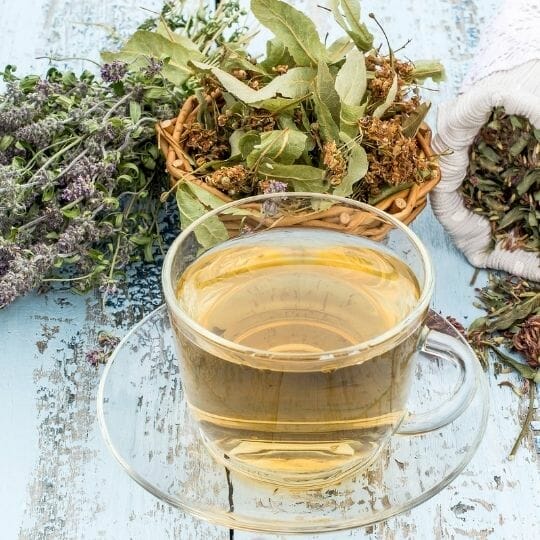
A Word of Caution about Herbs for Tea
All plants have properties in them that may cause allergies or undesirable side effects, especially if taken in large doses. The herbs for tea mentioned in this article are intended to be enjoyed as an occasional cup of tea now and then. Anyone intending to consume more than an occasional cup for pleasure should do more research about each individual herb and talk to their medical practitioner. This is particularly true for young children, pregnant women, anyone on medication or anyone with a chronic disease.
I would love to hear your experience with brewing your own herbal teas. Do you have a favourite flavor? Leave a comment below or tag me on Instagram at #getgettys.
Getty Stewart is an engaging speaker and writer providing tasty recipes, time-saving tips, and helpful kitchen ideas to make home cooking easy and enjoyable. She is a Professional Home Economist, author of Manitoba’s best-selling Prairie Fruit Cookbook, Founder of Fruit Share, mom and veggie gardener.


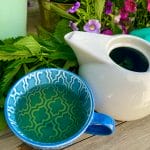
I have a big lemon verbena plant. I dried the leaves in the microwave and I made tea with it today and it’s delicious but I wouldn’t steep it longer than four minutes. If that very potent, I also use some dried mint for my garden. I’m hooked. I also bought my own biodegradable teabags. Great page looking forward to making more, and I have lots of other of the herbs mentioned in my garden. I’m curious how Rosemary would taste mixed with some other herbs of course.
thank you for this info! I had found it a little challenging to find specs regarding making tea with fresh herbs vs the dried. After spending a month in the Middle East, I developed a real taste (craving, even) for the tea and infused water they serve so often with fresh herbs from their gardens. I’ve grown Rosemary, Sweet Mint, Basil, Oregano, Ginger and Sage for years but only used them for cooking. Now I am so into the teas!
My favourite tea combination is dried mint, dried stevia, dried alfalfa and dried rhubarb or dried rose hip.
Sounds delicious, although I’ve never tried alfalfa in tea!